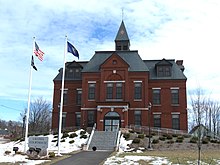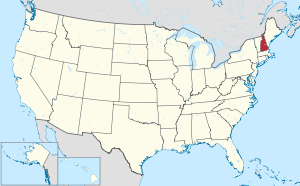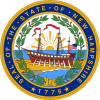Belknap County, New Hampshire
Belknap County | |
|---|---|
U.S. county | |
 Laconia District Court on Academy Square in Laconia | |
 Location within the U.S. state of New Hampshire | |
 New Hampshire's location within the U.S. | |
| Coordinates: 43°30′55″N 71°26′10″W / 43.515202°N 71.436073°W | |
| Country | |
| State | |
| Founded | 1840 |
| Named for | Jeremy Belknap |
| Seat | Laconia |
| Largest city | Laconia |
| Area | |
| • Total | 470.0 sq mi (1,217 km2) |
| • Land | 401.8 sq mi (1,041 km2) |
| • Water | 68.2 sq mi (177 km2) 14.5% |
| Population (2010) | |
| • Total | 60,088 |
| • Estimate (2019) | 61,303 |
| • Density | 151.9/sq mi (58.6/km2) |
| Time zone | UTC−5 (Eastern) |
| • Summer (DST) | UTC−4 (EDT) |
| Congressional districts | 1st, 2nd |
| Website | www |
Belknap County (/ˈbɛlnæp/) is a county in the U.S. state of New Hampshire. As of the 2010 census, the population was 60,088.[1] The county seat is Laconia.[2] It is located in New Hampshire's Lakes Region, slightly southeast of the state's geographic center. Belknap County comprises the Laconia, NH Micropolitan Statistical Area, which in turn constitutes a portion of the Boston-Worcester-Providence, MA-RI-NH-CT Combined Statistical Area.
History[]
Belknap County was organized in 1840 by removing parts of northeastern Merrimack County and northwestern Strafford County.[3] It is named for Dr. Jeremy Belknap, a renowned preacher, historian, and author of The History of New Hampshire. The first County Court was held within the town of Meredith, at a village known as Meredith Bridge on the Winnipesaukee River. In 1855, the town of Laconia was separated from Meredith.
Geography[]
According to the U.S. Census Bureau, the county has a total area of 469 square miles (1,210 km2), of which 400 square miles (1,000 km2) are land and 68 square miles (180 km2) (15%) are water.[4] It is the second-smallest county in New Hampshire by area. Most of the county's water area is part of Lake Winnipesaukee.
Adjacent counties[]
- Carroll County (north)
- Strafford County (east)
- Merrimack County (southwest)
- Grafton County (northwest)
Demographics[]
| Historical population | |||
|---|---|---|---|
| Census | Pop. | %± | |
| 1850 | 17,721 | — | |
| 1860 | 18,549 | 4.7% | |
| 1870 | 17,681 | −4.7% | |
| 1880 | 17,948 | 1.5% | |
| 1890 | 20,321 | 13.2% | |
| 1900 | 19,526 | −3.9% | |
| 1910 | 21,309 | 9.1% | |
| 1920 | 21,178 | −0.6% | |
| 1930 | 22,623 | 6.8% | |
| 1940 | 24,328 | 7.5% | |
| 1950 | 26,632 | 9.5% | |
| 1960 | 28,912 | 8.6% | |
| 1970 | 32,367 | 12.0% | |
| 1980 | 42,884 | 32.5% | |
| 1990 | 49,216 | 14.8% | |
| 2000 | 56,325 | 14.4% | |
| 2010 | 60,088 | 6.7% | |
| 2019 (est.) | 61,303 | [5] | 2.0% |
| U.S. Decennial Census[6] 1790-1960[7] 1900-1990[8] 1990-2000[9] 2010-2018[1] | |||
2000 census[]
As of the census[10] of 2000, there were 56,325 people, 22,459 households, and 15,496 families living in the county. The population density was 140 people per square mile (54/km2). There were 32,121 housing units at an average density of 80 per square mile (31/km2). The racial makeup of the county was 97.61% White, 0.29% Black or African American, 0.30% Native American, 0.55% Asian, 0.02% Pacific Islander, 0.16% from other races, and 1.06% from two or more races. 0.74% of the population were Hispanic or Latino of any race. 17.2% were of English, 13.6% Irish, 13.3% French, 12.2% French Canadian, 8.5% American, 6.9% Italian and 5.7% German ancestry. 95.0% spoke English, 2.7% French and 1.2% Spanish as their first language.
There were 22,459 households, out of which 30.4% had children under the age of 18 living with them, 55.7% were married couples living together, 9.20% had a female householder with no husband present, and 3% were non-families. 24.40% of all households were made up of individuals, and 9.70% had someone living alone who was 65 years of age or older. The average household size was 2.45 and the average family size was 2.91.
In the county, the population was spread out, with 23.60% under the age of 18, 6.70% from 18 to 24, 28.10% from 25 to 44, 26.40% from 45 to 64, and 15.10% who were 65 years of age or older. The median age was 40 years. For every 100 females, there were 97.10 males. For every 100 females age 18 and over, there were 95.10 males.
The median income for a household in the county was $43,605, and the median income for a family was $50,510. Males had a median income of $34,741 versus $25,445 for females. The per capita income for the county was $22,758. About 4.50% of families and 6.10% of the population were below the poverty line, including 7.60% of those under age 18 and 4.90% of those age 65 or over.
2010 census[]
As of the 2010 United States Census, there were 60,088 people, 24,766 households, and 16,609 families living in the county.[11] The population density was 150.1 inhabitants per square mile (58.0/km2). There were 37,386 housing units at an average density of 93.4 per square mile (36.1/km2).[12] The racial makeup of the county was 96.6% white, 1.2% Asian, 0.5% black or African American, 0.2% American Indian, 0.2% from other races, and 1.3% from two or more races. Those of Hispanic or Latino origin made up 1.2% of the population.[11] In terms of ancestry, 20.8% were English, 20.7% were Irish, 8.5% were Italian, 8.0% were German, 7.1% were French Canadian, and 6.6% were American.[13]
Of the 24,766 households, 28.5% had children under the age of 18 living with them, 52.5% were married couples living together, 9.8% had a female householder with no husband present, 32.9% were non-families, and 25.7% of all households were made up of individuals. The average household size was 2.39 and the average family size was 2.84. The median age was 44.7 years.[11]
The median income for a household in the county was $54,929 and the median income for a family was $64,875. Males had a median income of $46,378 versus $34,690 for females. The per capita income for the county was $28,517. About 5.2% of families and 8.6% of the population were below the poverty line, including 8.7% of those under age 18 and 10.0% of those age 65 or over.[14]
Politics and government[]
Belknap County has become the most Republican county in New Hampshire: the Republican Party is the majority political party in the county, holding 16 of 18 seats in the General Court as of January 2019. Since 1888, only three Democrats have won Belknap County: Woodrow Wilson in 1912 when the Republican Party was mortally divided between William Howard Taft and Theodore Roosevelt; 1964, when Lyndon B. Johnson swept the Northeast due to Republican Barry Goldwater's conservative views regarding the Civil Rights Movement; and 2008, when Barack Obama swept every county in New England bar one. In 2020, Senator Jeanne Shaheen became the first Democrat to win Belknap County in a Senate race in over 50 years.[15]
County Commission[]
The executive power of Belknap County's government is held by three county commissioners, each representing one of the three commissioner districts within the county.
| District | Commissioner | Hometown | Party |
|---|---|---|---|
| 1 | Peter Spanos (Chair) | Winnisquam | Republican |
| 2 | Glen Waring (Vice Chair) | Gilmanton | Republican |
| 3 | Hunter Taylor (Clerk) | Alton | Democrat |
In addition to the County Commission, there are five directly-elected officials: they include County Attorney, Register of Deeds, County Sheriff, Register of Probate, and County Treasurer.[17]
| Office | Name |
|---|---|
| County Attorney | Andrew Livernois (R) |
| Register of Deeds | Judith McGrath (R) |
| County Sheriff | William Wright (R) |
| Register of Probate | Alan Glassman (R) |
| County Treasurer | Michael Muzzey (R) |
General court[]
The legislative branch of Belknap County is made up of all of the members of the New Hampshire House of Representatives from the county. In total, there are 18 members from nine different districts. After the 2020 elections, the party distribution and representatives were as follows.
| Affiliation | Members | Voting share | |
|---|---|---|---|
| Democratic Party | 0 | 0% | |
| Republican Party | 18 | 100% | |
| Total | 18 | 100% | |
Communities[]
There are ten towns and one city in Belknap County.
City[]
- Laconia (county seat)
Towns[]
- Alton
- Barnstead
- Belmont
- Center Harbor
- Gilford
- Gilmanton
- Meredith
- New Hampton
- Sanbornton
- Tilton
Census-designated places[]
Villages[]
See also[]
References[]
- ^ Jump up to: a b "State & County QuickFacts". United States Census Bureau. Archived from the original on February 5, 2016. Retrieved September 24, 2013.
- ^ "Find a County". National Association of Counties. Archived from the original on July 4, 2012. Retrieved June 7, 2011.
- ^ "COUNTY LIST - New Hampshire Genealogy and History AT SEARCHROOTS". searchroots.com. Archived from the original on 2011-07-16. Retrieved 2008-09-15.
- ^ "2010 Census Gazetteer Files". United States Census Bureau. August 22, 2012. Archived from the original on 2014-12-27. Retrieved December 27, 2014.
- ^ "Population and Housing Unit Estimates". Retrieved May 16, 2019.
- ^ "U.S. Decennial Census". United States Census Bureau. Retrieved December 27, 2014.
- ^ "Historical Census Browser". University of Virginia Library. Retrieved December 27, 2014.
- ^ "Population of Counties by Decennial Census: 1900 to 1990". United States Census Bureau. Retrieved December 27, 2014.
- ^ "Census 2000 PHC-T-4. Ranking Tables for Counties: 1990 and 2000" (PDF). United States Census Bureau. Retrieved December 27, 2014.
- ^ "U.S. Census website". United States Census Bureau. Retrieved January 31, 2008.
- ^ Jump up to: a b c "DP-1 Profile of General Population and Housing Characteristics: 2010 Demographic Profile Data". United States Census Bureau. Archived from the original on 2020-02-13. Retrieved 2016-01-12.
- ^ "Population, Housing Units, Area, and Density: 2010 - County". United States Census Bureau. Archived from the original on 2020-02-13. Retrieved 2016-01-12.
- ^ "DP02 SELECTED SOCIAL CHARACTERISTICS IN THE UNITED STATES – 2006-2010 American Community Survey 5-Year Estimates". United States Census Bureau. Archived from the original on 2020-02-13. Retrieved 2016-01-12.
- ^ "DP03 SELECTED ECONOMIC CHARACTERISTICS – 2006-2010 American Community Survey 5-Year Estimates". United States Census Bureau. Archived from the original on 2020-02-13. Retrieved 2016-01-12.
- ^ David Leip. "Dave Leip's Atlas of U.S. Presidential Elections". uselectionatlas.org.
- ^ Leip, David. "Dave Leip's Atlas of U.S. Presidential Elections". uselectionatlas.org. Retrieved 5 April 2018.
- ^ "Archived copy". Archived from the original on 2018-08-07. Retrieved 2018-08-07.CS1 maint: archived copy as title (link)
- ^ "General Election Winners - 11/03/2020" (PDF). New Hampshire Secretary of State's Office. 11 November 2020. Retrieved 8 December 2020.
External links[]
| Wikimedia Commons has media related to Belknap County, New Hampshire. |
- New Hampshire counties
- Belknap County, New Hampshire
- Greater Boston
- 1840 establishments in New Hampshire
- Populated places established in 1840


